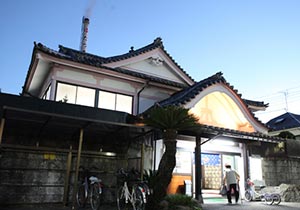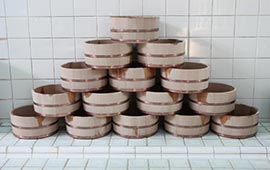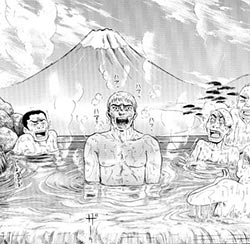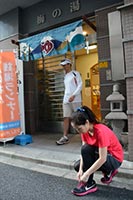Web Japan > Trends in Japan > Pop Culture > Sento: Public Bath
Sento: Public Bath
Relaxing in Japanese Style
Japan is home to a wealth of leisure bathing facilities ranging from hot springs to large theme park-like baths. Among these are sento, easily accessible public baths with extremely large bathtubs, which are the face of public bathing in Japan. From the sticky months of summer to the frigid days of winter, sento with their unique architectural designs have popularized a style of public bathing that is the “culture of the general public,” an indispensable part of life in Japan, and one that has been passed down across time to today.

A massive painting of Mt. Fuji on the wall at sento in Tokyo. Inari-yu is famous as a filming location for a movie based on the popular comic Thermae Romae. (Inari-yu, Tokyo)
Pleasure of General Public

The bandai counter. Here customers can buy items such as towels, soap and shampoo while paying the entrance fee. (Inari-yu, Tokyo)
Enlarge photoWith evening twilight, there is a visible jump in the number of people ducking under the cloth curtain, or noren emblazoned with the word “hot water,” at the sento entrance. Once inside the entrance, they shed their shoes and step up to pay admission at the traditional counter or platform, known as a bandai, where the bath attendant sits. Today many sento facilities have opted to renovate their entrances with more modern counters, but many people still have a special place in their hearts for old-school bandai. The entrance fee varies by area but for adults it will run between 300 yen and 450 yen.
Once inside and disrobed, patrons put their clothes in a locker and proceed to the bath. Open the door and you will find a shiny tile floor, high ceilings to keep air circulating, and massive bathtubs filled with hot water. But simply racing to jump in the bath is a no-no. First, etiquette calls for bathers to wash themselves well. Likewise, bathers are not to put their towels in the bathwater, which is why you see many people in the bath with their towels on their heads.
Community baths charging admission for bathing trace their roots back to the first half of the 12th century. At that time, steam baths were the norm. Soaking in hot baths was a practice that first arrived on the scene in modern-day Tokyo during what was called the Edo period (1603-1867). Back then, the city of Edo and its citizens were buffeted by sea breezes carrying sand and dust. These baths were a way for people to clean off the grime each day and no doubt an essential and enjoyable part of each day.
Left: A stack of wooden washbasins, once a common sight at sento. Its stock of wooden washbasins are replaced each year. (Inari-yu, Tokyo)
Right: The weathered scale, massage chair and fan have seen their share of action. These are three must-have items for public bath changing rooms. (Inari-yu, Tokyo)
Across time, public baths have been home to lively conversations in, post-bathing games of shogi (Japanese chess) in the changing room or simply gazing at the scenic view of a garden. Public baths have offered a space for people to relax and do as they like – something that has clearly remained unchanged over hundreds of years.
Towering Paintings of Mt. Fuji

As evident by its beautiful exterior, some bathes was built using building methods for temples and shrines. (Tatsu-no-yu, Tokyo)
Enlarge photoVisit a sento and you are likely to see a wall painted with a towering image of Mt. Fuji. In fact, this custom is so pervasive that these paintings of Mt. Fuji are practically synonymous with sento. In the past, the walls of sento were used for advertising and it was at this time that sento, primarily in Tokyo, began to have their walls painted with images of Mt. Fuji. Skilled painters would use four colors of paint to blend the necessary shades and with brushes and rollers finish the job in no time. Today there are only two painters in Tokyo that still paint such pictures.
One construction style that is typical among sento is that of miya-tsukuri, or tiled roofs typically used for shrines. Originally adopted as a means of building sento in the early 20th century, this practice has been passed down as building structure for sento. In recent years, many sento have undergone renewals and been rebuilt as modern buildings. In Tokyo today, however, you can still find numerous bathhouses with architecture possessing this traditional elegance and flavor. At such places, it is easy to imagine how these stylishly built sento flourished as a favorite form of leisure among the public for many years.
Thermae Romae Boom
Left: A scene from the popular comic Thermae Romae, which has been made into both a film and an animated movie. Written by Mari Yamazaki, this best-selling manga depicts the adventures of the main character, who somehow travels through time from ancient Rome, ending up in a Japanese public bath. © Enterbrain Inc.
Right: The DVD cover of the film Thermae Romae, produced by Toho Co. © Thermae Romae Production Committee
While many people with baths at home do enjoy a nice soak at a local sento, the proliferation of baths in the home has prompted a drop in the number of sento users. Likewise, after peaking at more than 20,000 in the 1960s, sento numbers have fallen to around 5,000 today.
Sento, with their reputation as a place for the “culture of the general public,” have in recent years been reconsidered and taken on new meaning as they are appreciated from different angles. Spurring this popular rethinking of sento is the hit comic Thermae Romae, which takes as its central theme the bath-loving culture of Japan and its people.
In the story, Lucius travels through space and time from ancient Rome to find himself in a modern-day Japanese bathhouse. Subsequently, he takes what he learns about sento and Japanese bath culture back to his own time and introduces it to ancient Rome. This story has prompted many young Japanese people to reconsider Japanese culture. The film is making waves both domestically and overseas. The film took the top box-office spot in Japan for the first half of the year after its release in April 2012. In addition, the film is to be released in 12 countries and territories, including Italy, France and Hong Kong.
A ”Base” for Runners
In addition, another factor helping to attract new customers to public baths in the heart of Tokyo is special “runners’ station” services catering to urban runners.
Since the nation’s largest marathon, the Tokyo Marathon, with its field of 30,000 participants began in 2007, an unprecedented running boom has taken hold of the nation’s capital. Indeed, many runners who work in central Tokyo and aspire to run in the race train by running laps around the Imperial Palace. A shortage of places to change and clean up after a run has thrust sento into the limelight as a runner’s haven.
Public baths in central Tokyo abound with conversations about running – with bathers being heard to say things such as “How many laps did you run?” and “I’ll have to try that.” Today the runner-heavy clientele of sento in central Tokyo has resulted in a new bathing environment where both runners and non-runners alike engage in fun and lively talk about racing and staying in shape.
Today people in urban Japan are beginning to rediscover the allure of public baths, which offer both a great place to relax and one to socialize and exchange information.
(January 2013)
- Noryo (August 2012)






